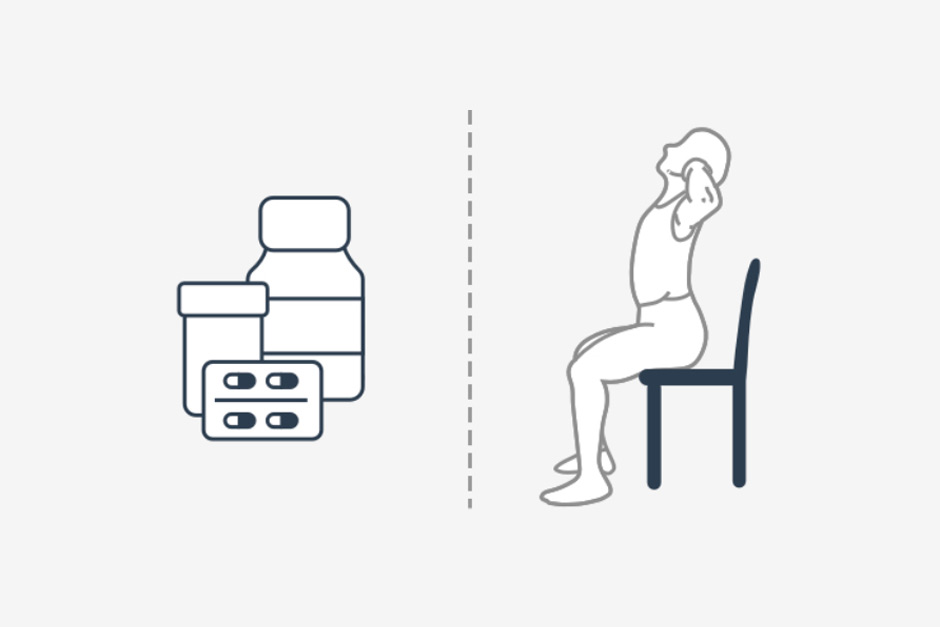Prior to starting any type of treatment, it’s important to see a spine specialist to develop an appropriate treatment program for your specific condition and medical history. Based on information you give your doctor spine surgery is not always the answer.
The main goals for managing back pain usually include:
- Providing enough pain relief to be able to actively participate with physical therapy and rehabilitation
- Preventing further injury or stress to the spine through improved ergonomics and posture
- Maintaining ability to function at home and at work
Ergonomics is the process of designing or arranging workplaces, products and systems so that they fit the people who use them.
There are several non-surgical options your doctor may recommend. For example, medication may be combined with physical therapy. Let’s review a few of the common resources here:
Medication
Typical pain medications used to treat back pain include acetaminophen, NSAIDs (non-steroidal anti-inflammatory drugs), oral steroids, narcotic drugs, muscle relaxants, and anti-depressants. Each type of medication has strengths, limitations, and risks. Your particular problem and overall health will determine which pain reliever, if any, is prescribed to you.
Opioid medications are generally not used as the first, only, or the long-term line of treatment for chronic back pain. Many opioids are addictive and don’t address the underlying cause of the pain. Opioids should be prescribed only after a thorough exam by a specialist and if other drugs have failed to provide relief.
Remember: Just like prescription medications, over the counter drugs can cause serious side effects.
Physical Therapy & Home Exercises
As counterintuitive or impossible as it sounds, exercise, stretching, and movement can help relieve your spinal pain. Exercise is the foundation of chronic back pain treatment. Your doctor and physical therapist (PT) will have recommendations for what types of exercise would be best for you, and they will be able to caution you against certain exercises.
One option that does not include spine surgery to help treat back pain is physical therapy. Physical Therapy (PT) will usually combine inactive therapy and therapeutic exercise. Inactive therapy includes heat or ice packs, ultrasound, electrical stimulation, and massage. Active therapy exercise may include stretching and prescribed exercises to help stabilize the spine, build strength and endurance, and increase flexibility.
DoctorPlan Tip: You can try some of the strength or flexibility exercises in the DoctorPlan app. To ensure your safe recovery, talk to your doctor before starting any exercise regimen or activity.
Injection-based Treatments
Nerve blocks, epidural steroid injections, nerve ablations and other types of injection-based procedures are available for chronic back pain. They are used when the source of your back pain is known and can sometimes help rule out certain causes if the treatment doesn’t work. Injections may stop or reduce pain for a certain period of time, but they are not intended as long-term solutions and shouldn’t be used in isolation. Your doctor will let you know if spine surgery may be needed as a more invasive option.
The most common type of injection used to help alleviate the symptoms of spinal stenosis is an epidural injection. This type of injection places medication into the space that surrounds specific nerve roots. This medication helps to reduce inflammation and acute pain that radiates into the arms or legs.
Mindfulness Based Stress Reduction & Cognitive-Behavioral Therapy
Mindfulness-based stress reduction combines elements of mindfulness meditation and yoga, and cognitive-behavioral therapy is a form of psychotherapy that trains you to modify specific thoughts and behaviors.
Studies demonstrate that these kinds of therapies, that don’t rely on drugs, can help people manage their chronic lower back pain as it addresses the power of the mind/body connection. Meditation can help ease pain by moving your focus to something calmer.
It is easy to try: sit, or lay down, in a place that is free of interruptions, as much as possible, then gently close your eyes to quiet other distractions and just focus simply on your breath.
DoctorPlan Tip: You can explore new exercises in the stress relief section in the DoctorPlan app.
Diet
Some diets are highly inflammatory, especially those high in trans fats, refined sugars, and processed foods. Consult with your doctor to see if your diet could be contributing to your chronic back pain and how you could change it. A proper diet that also includes calcium and vitamin D will keep your spine strong and away from needing spine surgery.
Lifestyle Modifications
When you have chronic pain, it’s important to accept your limitations and adapt. Take a break when mowing the lawn or make several trips when carrying groceries. Take note of the activities that worsen your pain and avoid them if possible. Not only could this help your back feel better, but it could also prevent the underlying condition from advancing.
Complementary, Integrative & Alternative Medicine
Some patients use medical treatments that are not part of mainstream medicine. When you are using these types of care, it may be called complementary, integrative, or alternative medicine.
- If a non-mainstream practice is used together with conventional medicine, it’s considered When doctors and facilities offer both types of care, it is called integrative medicine. Integrative health care often brings conventional and complementary approaches together.
- If a non-mainstream practice is used in place of conventional medicine, it’s considered alternative.
As with any treatment for back pain or neck pain, talk to your doctor before you try something new, whether it’s to do with a provider’s treatment or an additional vitamin or supplement.
When Should I See My Doctor?
If you find that self-care is not reducing your pain or even making it worse, you’ll want to visit your doctor to explore further treatment options.

